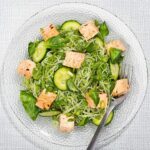Imagine a world where decadent desserts don’t necessitate guilt. This guide unveils the secrets to crafting delicious treats that satisfy your sweet tooth without compromising your health goals. We’ll explore healthy ingredient swaps, mindful eating techniques, and creative recipe adaptations, transforming classic desserts into guilt-free indulgences. Prepare to embark on a culinary journey that redefines the meaning of balance, where rich flavors dance harmoniously with nutritional wisdom.
From understanding the nutritional profiles of various sweeteners and flours to mastering portion control and mindful eating strategies, we’ll equip you with the knowledge and tools to create and enjoy desserts that nourish your body and soul. We’ll delve into the art of adapting existing recipes, discovering exciting flavor combinations, and even mastering the visual presentation of your healthy creations. Get ready to redefine your dessert experience!
Portion Control and Mindful Eating
Enjoying desserts doesn’t have to mean abandoning healthy eating habits. The key lies in mastering portion control and practicing mindful eating, allowing you to savor sweet treats without the guilt or the unwanted weight gain. By understanding the psychological aspects of cravings and implementing practical strategies, you can cultivate a balanced relationship with dessert.
Strategies for managing dessert portions are surprisingly simple yet highly effective. Visualizing the appropriate serving size before you even begin can be incredibly helpful. Imagine a small scoop of ice cream, a single square of chocolate, or a single slice of cake, precisely measured. Using smaller plates and bowls creates an optical illusion of a larger portion, satisfying your eyes while actually consuming less. Another powerful technique involves packing your dessert in advance in individual containers, portioned out perfectly, for a pre-determined serving size.
Strategies for Portion Control
Several effective methods exist to manage portion sizes when indulging in desserts. These techniques focus on creating visual cues and using practical tools to regulate intake.
- Pre-portioning: Scoop out a single serving into a small bowl or container *before* you even sit down to eat. This removes the temptation to go back for seconds.
- Using Smaller Plates and Utensils: A smaller plate makes a smaller portion look more substantial, thus satisfying your visual appetite. Smaller spoons or forks will naturally slow down your eating pace.
- The “Rule of Thirds”: Divide your dessert into three equal portions. Eat the first portion slowly, savoring each bite. Pause, and then decide if you truly want more. If so, proceed to the second, and repeat the process before the third.
Mindful Eating Techniques
Mindful eating is a powerful tool for preventing overindulgence. It encourages paying attention to your senses and body signals, leading to a more conscious and satisfying eating experience.
- Savor Each Bite: Slow down and truly taste your dessert. Notice the texture, the aroma, and the flavors. This helps you appreciate the experience more fully and prevents mindless munching.
- Check-in with Your Body: Before reaching for a second helping, pause and ask yourself if you’re truly hungry or just eating out of habit or boredom. Pay attention to feelings of fullness and satisfaction.
- Eat in a Calm Environment: Avoid distractions like television or your phone. Focus solely on your dessert and the experience of eating it.
Managing Dessert Cravings
Understanding the psychological roots of dessert cravings is crucial for effective management. Often, cravings are triggered by stress, emotions, or simply habit. Addressing these underlying factors is key to breaking the cycle.
- Identify Triggers: Keep a food journal to identify situations, emotions, or times of day when you crave dessert. This awareness allows you to develop coping mechanisms.
- Find Healthy Alternatives: When a craving hits, try satisfying it with a healthier option, such as fruit, yogurt, or a small piece of dark chocolate.
- Address Underlying Emotions: If stress or boredom fuels your cravings, find healthy ways to manage these emotions, such as exercise, meditation, or spending time with loved ones.
Building a Balanced Dessert-Eating Habit
Creating a sustainable relationship with dessert involves a combination of planning, mindful choices, and self-compassion.
- Plan Your Indulgences: Instead of restricting yourself completely, schedule specific times for enjoying dessert, perhaps once or twice a week.
- Choose Wisely: Opt for desserts made with whole ingredients and less added sugar. Homemade options often allow for better control over ingredients and portion sizes.
- Practice Self-Compassion: Don’t beat yourself up if you occasionally overindulge. Simply acknowledge it, learn from it, and move on. Focus on overall healthy eating patterns, not perfection.
Recipe Adaptation for Healthier Desserts
Indulging in desserts doesn’t have to mean sacrificing your health. By making smart substitutions and adjustments, you can significantly reduce the sugar and fat content in your favorite recipes without compromising the deliciousness. This involves understanding the role of different ingredients and creatively finding healthier alternatives that deliver similar textures and flavors. The key is to experiment and discover what works best for you and your palate.
Adapting recipes often requires a delicate balance. Simply reducing sugar might result in a bland dessert, while cutting fat too drastically could lead to a dry or crumbly texture. The goal is to find the sweet spot – the point where the health benefits are maximized without sacrificing the sensory experience. This often involves using natural sweeteners, incorporating healthier fats, and employing clever baking techniques.
Reducing Sugar and Fat in Classic Desserts
This section details practical strategies for adapting existing recipes to lower sugar and fat content. Imagine transforming a rich, decadent chocolate cake into a lighter, healthier version that still satisfies your cravings. This is achievable through mindful ingredient substitutions. For instance, applesauce or mashed banana can replace a portion of the oil or butter, adding moisture and natural sweetness. Greek yogurt can also substitute for some of the fat in cakes and brownies, adding protein and creaminess. Using whole wheat flour instead of all-purpose flour adds fiber and nutrients, enhancing the overall nutritional profile. Finally, reducing the overall sugar by 25-50% (depending on the recipe and your preference) often yields surprisingly delicious results, particularly when combined with the other substitutions. Experimentation is key; start with smaller reductions and gradually adjust to your liking.
Examples of Healthier Dessert Recipes
Several recipes beautifully demonstrate the balance between indulgence and nutrition. A vibrant berry crumble, for instance, uses less refined sugar and incorporates the natural sweetness of fresh berries and a whole-wheat oat topping. The oats provide fiber, and the berries offer antioxidants, creating a dessert that’s both delicious and beneficial. Another example is a dark chocolate avocado mousse. The creamy texture of avocado replaces the need for excessive cream or butter, while the dark chocolate provides intense flavor and antioxidants. The rich, decadent texture is surprisingly satisfying while being significantly lower in fat and sugar compared to traditional mousse recipes. A final example would be zucchini bread. The addition of zucchini adds moisture and nutrients without significantly altering the taste, resulting in a healthier and surprisingly moist loaf.
Recipes Categorized by Dietary Restrictions
Understanding dietary needs is crucial when creating inclusive dessert options.
Below is a conceptual Artikel of how dessert recipes could be categorized. Each category would include several specific recipes. Note that these are just examples, and the actual recipes would need to be fully developed.
| Dietary Restriction | Example Recipes |
|---|---|
| Vegan | Vegan Chocolate Chip Cookies, Vegan Brownies, Raw Vegan Cheesecake |
| Gluten-Free | Gluten-Free Apple Crisp, Gluten-Free Chocolate Cake, Gluten-Free Lemon Bars |
| Dairy-Free | Dairy-Free Ice Cream, Dairy-Free Chocolate Pudding, Dairy-Free Fruit Cobbler |
| Refined Sugar-Free | Date-Sweetened Brownies, Banana Bread with Maple Syrup, Coconut Flour Cookies with Stevia |
Creating a Healthier Chocolate Cake
This step-by-step guide details how to transform a classic chocolate cake into a healthier alternative.
This recipe focuses on reducing sugar and fat while maintaining the rich chocolate flavor and moist texture. Visualize a beautifully layered chocolate cake, dark and glossy, yet lighter and less dense than its traditional counterpart.
- Ingredients: 1 ½ cups whole wheat pastry flour, ¾ cup unsweetened cocoa powder, 1 ½ teaspoons baking powder, ¾ teaspoon baking soda, ¾ teaspoon salt, 1 cup unsweetened applesauce, ½ cup unsweetened almond milk, ½ cup maple syrup, 2 large eggs, 1 teaspoon vanilla extract, ½ cup strong brewed coffee (cooled).
- Instructions: Preheat oven to 350°F (175°C). Grease and flour two 9-inch round cake pans. In a large bowl, whisk together flour, cocoa powder, baking powder, baking soda, and salt. In a separate bowl, whisk together applesauce, almond milk, maple syrup, eggs, and vanilla extract. Gradually add the wet ingredients to the dry ingredients, mixing until just combined. Stir in the cooled coffee. Pour batter evenly into the prepared cake pans.
- Baking: Bake for 30-35 minutes, or until a wooden skewer inserted into the center comes out clean. Let the cakes cool in the pans for 10 minutes before inverting them onto a wire rack to cool completely.
- Frosting (Optional): A simple dairy-free frosting can be made with avocado, cocoa powder, maple syrup, and vanilla extract, blended until smooth and creamy. This adds richness without excessive fat and sugar.
Exploring Flavor Combinations
Unlocking the potential of healthy desserts lies in the art of flavor exploration. By skillfully combining ingredients and balancing taste profiles, we can create decadent treats that are both nutritious and utterly delightful. This involves moving beyond simple sweetness and incorporating a symphony of flavors to achieve a truly satisfying experience. The key is to understand how different tastes interact and complement each other, creating a complex and memorable flavor profile.
Sweetness, while undeniably a key component of desserts, shouldn’t be the sole player. A successful dessert balances sweetness with contrasting flavors like tartness, bitterness, and spice. This interplay of tastes prevents the dessert from becoming cloying and adds depth and complexity. Tartness, provided by fruits like berries or citrus, cuts through sweetness, offering a refreshing counterpoint. A hint of bitterness, perhaps from dark chocolate or unsweetened cocoa powder, adds sophistication and prevents the sweetness from being overwhelming. Finally, warming spices like cinnamon, ginger, or cardamom can add a layer of intrigue and warmth, enhancing the overall sensory experience.
Seasonal Fruit and Vegetable Dessert Recipes
Seasonal produce offers a wealth of flavor possibilities and ensures the freshest, most vibrant ingredients. Using what’s in season also supports local farmers and reduces the environmental impact of food transportation.
- Summer Berry Crumble: Imagine a warm, bubbly crumble topping generously covering a medley of juicy summer berries – raspberries, blueberries, and strawberries – their sweetness punctuated by a hint of lemon zest. The crumble itself is made with oats, nuts, and a touch of maple syrup, offering a satisfying crunch.
- Roasted Sweet Potato and Apple Pie: A twist on a classic, this pie features earthy roasted sweet potatoes and tart apples, baked in a whole-wheat crust. The sweetness of the filling is balanced by the spice of cinnamon and nutmeg, creating a comforting and flavorful dessert.
- Pumpkin and Ginger Muffins: These moist muffins are bursting with the warm flavors of autumn. The creamy pumpkin puree is complemented by the spicy kick of ginger, creating a delightful balance of sweetness and spice. A touch of maple syrup adds subtle sweetness without being overpowering.
Desserts Incorporating Healthy Fats
Healthy fats, far from being detrimental, are essential for creating rich, creamy textures and enhancing the overall flavor profile of desserts. Nuts, seeds, and avocados are excellent sources of healthy fats that contribute significantly to the sensory experience.
- Avocado Chocolate Mousse: Creamy and decadent, this mousse uses ripe avocado as its base, lending a velvety texture and subtle sweetness. The richness of the avocado is beautifully complemented by the intense bitterness of dark chocolate, creating a surprisingly luxurious dessert.
- Nut and Seed Brittle: A crunchy and satisfying treat, this brittle features a mix of nuts (almonds, pecans, walnuts) and seeds (pumpkin, sunflower) roasted to perfection with a touch of maple syrup and a pinch of sea salt. The variety of textures and subtle saltiness enhances the overall flavor profile.
- Tahini Date Energy Bites: These no-bake energy bites combine the nutty flavor of tahini with the sweetness of dates, creating a naturally sweet and satisfying snack or dessert. The addition of oats and chia seeds adds texture and nutritional value.
Creative Dessert Presentation

A visually stunning dessert elevates the entire eating experience, transforming a simple treat into a memorable moment. The artful arrangement of colors, textures, and components not only pleases the eye but also subtly influences our perception of taste and overall satisfaction, even with healthier ingredients. A beautifully presented dessert speaks to our senses before we even take a bite, creating anticipation and enhancing enjoyment.
Creating visually appealing healthy desserts requires a mindful approach to both aesthetics and nutritional value. The key lies in understanding how different ingredients can contribute to the overall visual appeal while maintaining a commitment to wholesome components. By strategically utilizing color contrasts, varying textures, and thoughtful plating techniques, we can create desserts that are both delicious and delightful to behold.
Plating Techniques for Healthy Desserts
Strategic plating is crucial for enhancing the visual impact of a healthy dessert. Consider the shape and size of your plate, the placement of elements, and the use of negative space to create balance and visual interest. A simple, elegant approach can often be more effective than overly complicated arrangements. For instance, a vibrant berry crumble could be served in a small, shallow bowl, allowing the juicy berries to peek through the golden crumble topping. The contrast of the deep red berries against the warm brown crumble creates a visually appealing scene. Alternatively, a layered parfait in a clear glass showcases the different textures and colors of each layer – perhaps a creamy coconut yogurt base, followed by layers of granola and fresh fruit. The transparency of the glass allows for a full view of the layered beauty.
Utilizing Color and Texture
The interplay of colors and textures significantly impacts the visual appeal of a dessert. Think beyond simple combinations. Consider a vibrant green matcha mousse served alongside a scattering of toasted coconut flakes and a few fresh raspberries. The deep green of the mousse contrasts beautifully with the white of the coconut and the bright red of the raspberries. The combination of smooth mousse, crunchy coconut, and juicy raspberries creates a captivating textural experience. Another example could be a dark chocolate avocado mousse, rich and dark in color, presented with a sprinkle of chili flakes for a touch of vibrant red and a subtle hint of heat. The smooth, creamy texture of the mousse contrasts delightfully with the crunchy chili flakes.
Examples of Unique Dessert Presentations
Several creative presentation ideas can elevate healthy desserts. Imagine a deconstructed berry tart: individual components such as a shortbread crust, homemade berry compote, and a dollop of coconut whipped cream, artfully arranged on a plate, allowing for a personalized and interactive experience. Or consider a colorful fruit skewers arranged on a bed of fresh mint leaves, with a light honey-lime drizzle. The vibrant colors of the fruits, the freshness of the mint, and the subtle sheen of the drizzle create a visually stunning and refreshing dessert. For a more elegant presentation, a single scoop of a vibrant purple sweet potato ice cream could be placed on a small, dark plate, garnished with a few crystallized ginger pieces for a touch of texture and a subtle spice note. The contrast between the deep purple of the ice cream and the dark plate enhances the visual impact.
Ultimately, balancing indulgence and nutrition in desserts is about mindful choices and creative culinary exploration. By understanding the nutritional value of ingredients, practicing portion control, and embracing healthy recipe adaptations, you can enjoy the pleasure of dessert without sacrificing your well-being. Remember, it’s not about deprivation, but about finding delicious and nutritious alternatives that satisfy your cravings and support a healthy lifestyle. So, embrace the joy of baking and savoring delightful treats that are both satisfying and good for you.
FAQ Compilation
Can I use artificial sweeteners in healthy desserts?
While artificial sweeteners reduce sugar content, some studies link them to potential health concerns. It’s best to prioritize natural sweeteners in moderation or explore sugar-free options carefully.
How can I avoid overeating desserts even when they are healthy?
Practice mindful eating: savor each bite slowly, pay attention to your body’s fullness cues, and avoid distractions while eating. Set realistic portion sizes and choose desserts that are naturally more filling, like those with added protein or fiber.
Are all “healthy” desserts truly low in calories?
Not necessarily. While healthier alternatives exist, even these can be calorie-dense depending on ingredients and portion sizes. Always check nutritional information and practice mindful consumption.
What if I don’t like the taste of alternative flours?
Experiment with different types of alternative flours and combine them to find a blend that you enjoy. Start by substituting a small portion of traditional flour with a healthier alternative and gradually increase the ratio as you adjust to the taste and texture.


